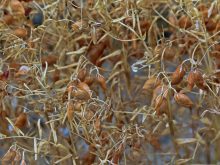Canada is benefitting from a sharp increase in Turkish lentil imports as the country meets soaring demand from one of its re-export markets.
“The most important phenomenon impacting the Turkish red lentil imports is the Iraqi market,” said Mehmet Sonmez, partner in Armada Foods, a large Turkish pulse processing firm.
The Iraqi government has been tendering for pulses the past two years, shifting demand from private sector hands to government control.
Read Also

VIDEO: Catch up with the Western Producer Markets Desk
The Western Producer Markets Desk provides daily updates on agricultural markets, with recent video commentary including looks into canola, wheat, cattle and feed grains.
That shift has led to a considerable increase in Turkey’s lentil exports to Iraq and a corresponding need for the country to import more from Canada and other suppliers.
Turkey has been importing 450,000 to 500,000 tonnes of lentils per year the past couple of years.
“This year our expectation is the imports will be around the 350,000 to 400,000 tonne level,” Sonmez said in an email.
He did not provide an explanation for why the imports will fall this year. But it may have something to do with the anticipation of a large domestic crop.
Turkey’s red lentil crop has dodged the devastating drought ravaging the rest of the country.
The Turkish State Meteorological Service reports that cumulative rainfall from October 2022 through January 2023 was more than 40 percent below the national historic average, according to a recent report by the United States Department of Agriculture.
“(It is) the driest period on record in more than 60 years,” said the USDA.
The USDA is projecting a 17 percent year-over-year drop in Turkey’s oilseed production in 2023-24 as a result of the drought. And that is just a preliminary forecast. It could get worse.
But the country’s red lentil crop is not suffering the same fate, according to Tuba Memis, general manager of Memisoglu Tarim — TAT, one of the largest food companies in Turkiye.
That is because 90 percent of the country’s red lentils are produced in the southeastern region of the country in the provinces of Diyarbakir, Sanliurfa, Mardin, Adiyaman and Gaziantep.
The drought is not nearly as bad in that area as it is in the rest of Turkey, she said in an email.
Memis said March is the key moisture month for Turkish red lentil production. Rains during the first two weeks of the month have been ample in the southeast.
“So, the development of this season’s red lentil crop in Turkey is very good,” she said.
Sonmez said oilseeds production is concentrated in the southern and northwestern parts of the country that are experiencing severe to exceptional drought.
The red lentil area has moderate dryness by comparison, and the area received heavy rainfall last week, which has improved conditions.
“Timely rains in April will be crucial in determining the final yield outcome of the 2023 crop,” he said.
If those rains arrive, he is forecasting 300,000 to 350,000 tonnes of total lentil production, which would be similar to last year and above the five-year average.
That is because planted acreage is similar to last year, but 30 percent higher than the five-year average.
Memis’s forecast is only for red lentils. It does not include greens.
Growers planted 1.6 million acres of red lentils, which is the same as last year. Harvest starts in May and continues until the end of June.
She anticipates a red lentil crop of 230,000 to 250,000 tonnes, assuming no big weather problems for the remainder of the growing season.
That would be identical to last year’s production and double the year before that, which was a drought year.
In addition, there is an estimated 80,000 to 90,000 tonnes of carryover stocks from last year’s harvest.
Red lentil consumption in Turkey is around 255,000 to 300,000 tonnes per year.
Turkey is a large re-exporter of the crop, bringing in imported lentils, processing them and shipping them out to other countries in the region.
The country exported 470,000 tonnes of red lentils in 2022, 220,000 tonnes in 2021, and 325,000 tonnes in 2020.
It has shipped out 100,000 tonnes so far this year, through March 15, 2023.
“As Turkey’s exports of red split lentils increases every year, its imports are also increasing,” said Memis.
Turkey imported 468,000 tonnes of red lentils in 2022, with 81 percent of that volume coming from Canada. It bought 463,000 tonnes in 2021, with 77 percent of that sourced from Canada.
Canada is expected to retain its stranglehold on the Turkish market despite Australia’s bumper harvest of 1.4 million tonnes of red lentils, a 40 percent increase over the previous year.
Sonmez said Australian lentils used to be sought after in Turkey and its re-export destinations. They were considered to have the same characteristics as Turkish lentils and were preferred over Canadian product.
“This has completely changed over the years,” he said.
“Today, the market is resistant to buying Australian crop, making it a relatively illiquid asset for processors and traders.”
Turkish importers believe there should be a US$35 per tonne discount on Australian lentils versus Canadian product.
“Therefore, as long as Australians keep pricing their lentils at the same price as the Canadian (CFR Mersin), I do not think it is a threat to the Canadian sales,” said Sonmez.
Memis also does not anticipate a big surge in imports from Australia because Turkish processors do not like the quality and logistical problems associated with product from Down Under.
“Turkish companies prefer Canadian lentils for import due to their quality, reasonable price, and regular and strong supply capacity,” she said.
Memis thinks Australia’s lentils will instead be shipped to India, Bangladesh, Dubai and Egypt, displacing Canadian lentils in those markets.
“Therefore, Turkey, as Canada’s major market, will expect better prices from Canadian suppliers,” she said.
Contact sean.pratt@producer.com
















